What are violin bows made of? These are the best materials:
Why is horse hair the best for violin bow hair? What’s the difference between a pernambuco stick or a carbon fiber one?
In this article I will go into all regular materials violin bows are made of, which include horse hair, synthetic materials, types of wood, pearl and even turtle shell.
You’ll learn why certain materials are used and what difference they make.
Let’s take a look at the violin bow parts, which are made of different materials:
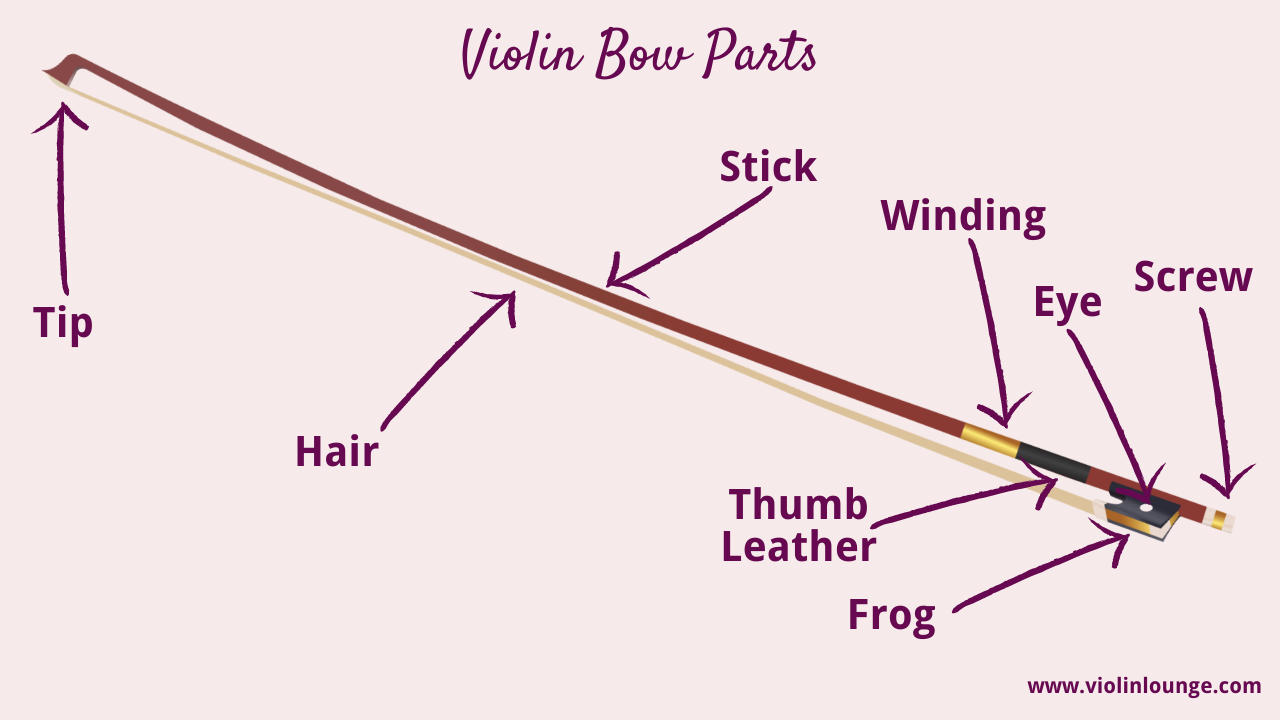
Read more details in this full article on violin bow parts.
The violin bow hair that touches the strings of the violin while playing is usually horse hair, but we’ll discuss alternatives below. The stick is made out of wood or carbon in a variety of quality levels. At the tip, you’ll find the tip plate and at the frog where you hold the violin bow we have a beautiful pearl inlay on the bottom (slide) and the side (Paris eye).
What are the best materials for a violin bow and why? Let’s go in depth…
Violin bow hair
Bow hair is the part of the bow that prompts the most questions. Is it actually made from horses, or can it be just any hair? How does the bow grab the strings? The vast majority of violin bows do indeed use horsehair, and have from the beginning.
Best horse hair for violin bows
Luthiers prefer to use hair from horses who live in very cold climates because they produce thicker hair to keep warm. The best choices are Siberian, Mongolian, Manchurian, Polish, and Argentinian. Stallion hair is best because it is cleaner than hair from mares. The hairs might be varying lengths and thicknesses, so they are sorted several times to find the ideal ones for bowmaking. Luthiers are very mindful of the quality of hairs in their bows, so many will sort the hairs yet again on their own. Violin bow hair can also be different colors: you probably have only seen white-haired bows, but cellists and bassists sometimes use black because they say it is coarser.
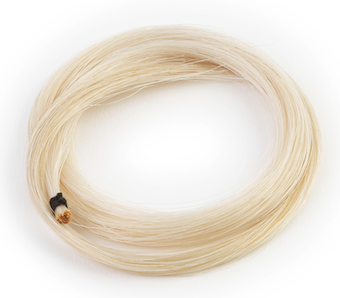
Horse hair alternatives
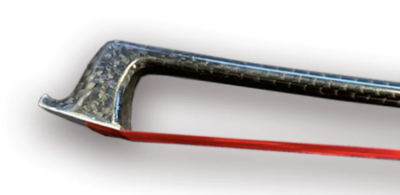 Horsehair is the most traditional and effective material, but we now have the technology to make bow hair out of other things. A company called Coruss has created synthetic bows that do not use any animal products (the vegan violin bow). According to their website, they noticed a decline in horsehair quality, which the Mongolian horse breeders said was due to hotter summers and more snowfall in winter. These changes affected the horses’ natural food supply, and thus affected the strength and quality of their hair. Coruss developed synthetic hair made from fibers that would be more durable than regular horsehair. As it is not affected by humidity and temperature, it can be played for several years without needing a rehair.
Horsehair is the most traditional and effective material, but we now have the technology to make bow hair out of other things. A company called Coruss has created synthetic bows that do not use any animal products (the vegan violin bow). According to their website, they noticed a decline in horsehair quality, which the Mongolian horse breeders said was due to hotter summers and more snowfall in winter. These changes affected the horses’ natural food supply, and thus affected the strength and quality of their hair. Coruss developed synthetic hair made from fibers that would be more durable than regular horsehair. As it is not affected by humidity and temperature, it can be played for several years without needing a rehair.
For the stick, Coruss uses either carbon fiber or a carbon fiber/pernambuco blend. Coruss also offers a special rosin meant for synthetic hair. The rosin is made from organic materials with eco-friendly techniques. Aside from its sustainability and longevity, Coruss hair also has visual appeal: you can choose from eight different colors for the hair! Synthetic hair is an intriguing option if you are open to trying new things.
Rehairing your violin bow
We briefly mentioned bow rehairs. Why is that necessary and how often should it be done? You may have occasionally had bow hairs break off while you were playing. If this happens too much, you will need to get a rehair to replace the ones you have lost. The hair is also affected by changes in humidity and temperature that stretch it out over time, and it is dirtied by dust and oils. The question of how often to rehair is rather personal. It depends on how much you play and how well you clean your bow. It never occurs to many people that simply cleaning the hairs thoroughly refreshes your sound and postpones the need for a rehair.
Watch a video of a violin bow maker doing a rehair right here.
How to clean your violin bow hair
To clean your bow hair, unscrew the screw from the frog so that the frog and hair separate from the stick. Dip a toothbrush into a small amount of rubbing alcohol and gently brush it through the bow hairs. Just be sure that the alcohol does not touch the wood of the bow and that you let the hairs dry completely before screwing the bow back together. You can also occasionally clean the wood of the bow with violin polish if there’s rosin build-up. If you are taking proper care of your bow, then you may only need a rehair once a year.
Watch this video to learn how to clean your violin bow hair and stick yourself.
Myth about violin bow hair hooks
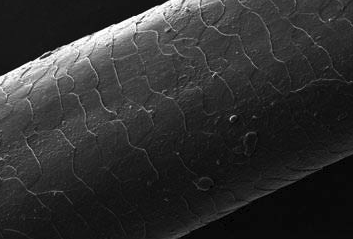 The other myth about rehairs is that horsehair gets worn out when the little “hooks” on it start to get dull. However, horsehair analyzed under a microscope is completely smooth. There are no hooks, it is the friction created by the rosin that makes the sound. To prove this, try playing on a new bow that has no rosin and see if you can make a sound!
The other myth about rehairs is that horsehair gets worn out when the little “hooks” on it start to get dull. However, horsehair analyzed under a microscope is completely smooth. There are no hooks, it is the friction created by the rosin that makes the sound. To prove this, try playing on a new bow that has no rosin and see if you can make a sound!
Violin bow stick
If the bow hair can be either natural or synthetic, what can the stick be made out of? Bowmakers use different materials depending on the desired quality and flexibility.
Terms you may have heard include brazilwood, sandalwood, and pernambuco. How are these three things different, and which is the best?
Pernambuco violin bows
We’ll start with pernambuco. François Xavier Tourte, the famous French bowmaker, introduced pernambuco in the 19th century. Ever since, it has been the preferred wood for bow-making due to its ideal density, strength, and flexibility. Pernambuco is the heartwood (innermost ring) of the paubrasilia echinata tree, the national tree of Brazil. Unfortunately for violinists, this tree is now listed as an Appendix II endangered species. This means that while the use of pernambuco is not banned, it is more strictly regulated. If pernambuco is ever moved into Appendix I, that would mean a near total ban on use, and you would need special permission to even travel with a pernambuco bow. While conservation efforts are being made, it is a slow process as paubrasilia echinata trees require very specific growing conditions.
Sandalwood or Brazil wood violin bows
If you’ve just gotten into violin playing, then your bow is most likely brazilwood or sandalwood.
Sandalwood is a yellow, fine-grained wood that is often used for student bows. Strictly speaking, brazilwood is the outer ring of the paubrasilia echinata tree. Pernambuco comes from the denser heartwood, brazilwood from the less finely grained outer layers. However, in reality other types of wood are sometimes used for bows and labeled as brazilwood, so it can be difficult to know the origin of the wood for sure. (It is also worth noting that only bowmakers distinguish between the inner and outer layers of paubrasilia echinata—in the lumber yard it is all considered brazilwood!) Brazilwood is considered less valuable than pernambuco because its density is not as ideal and because it loses its springiness much more quickly. However, depending on how well it has been cared for, not every pernambuco bow is in better shape than every brazilwood bow, so it is best to get the opinion of a professional.
Sandalwood violin bow
Sandalwood can be a great alternative to pernambuco if you’re tight in your budget. However it lacks the density and is more sensitive to changes in temperature and humidity, which can make it warp.
Carbon fiber violin bow
The uncertainty of pernambuco’s future availability has fueled the synthetic bow industry. There are three basic categories of synthetic bows: carbon composite (of various types), carbon fiber, and straight fiber.
Carbon composite violin bows
Carbon composite or fiberglass are often used for beginning student bows. They are durable and cheap to produce, but not very complex. Being offered for as cheap as $ 30 and still being usable, they are great for a tight budget. Usually for a wooden bow you’d have to spend more for a similar quality level. Carbon composite bows usually have a low percentage of carbon and a high percentage of epoxy, which affects the playing characteristics and sound.
Carbon fiber violin bows
Carbon fiber bows like CodaBow, JonPaul and Müsing are of a higher quality. Most of the time they have weaved look. The price and quality levels vary a lot from cheap bows around $ 100 to professional level carbon fiber bows of over $ 1,000. In my buying guide to carbon fiber bows you can see all the major brands including video demonstrations and reviews.
High tech straight fiber carbon fiber violin bows
Another fascinating synthetic option is Arcus. Arcus bows are based on the principle that wooden bows were created to go with gut strings, so we need a stronger bow for today’s metal strings and higher tension on our instruments. Just like violins, Arcus bows are hollow on the inside, giving them special resonance and flexibility. They are also lighter than standard wood bows. In my buying guide to carbon fiber bows right here I’ve tested and reviewed all classes and types of Arcus bows.
Many players still prefer traditional pernambuco bows, and if that is your preference that is fine! Every bow is unique however, so it is important to keep an open mind. High quality carbon bows are a good option if you are worried about damaging your bow through wear or humidity. Also they have no travel restrictions like antique wooden bows and maybe in the future pernambuco bows in general.
The violin bow that fits you is very personal, so it’s important that you try out different violins bows within your budget.
Materials of the Frog
Aside from the bow and the stick, bows incorporate other materials as well. The frog is not part of the stick, and is usually made from ebony. The “eye” in the center of the frog is for visual effect and typically made from mother-of-pearl.
Bows are mounted with nickel, silver, or gold. The type of metal used does not affect the sound quality of the bow, so why does this matter? Traditionally, bow makers used more expensive metals for higher quality wood. Now due to rising gold prices, using silver for very high quality bows is more common. Not only that, but some excellent makers use nickel out of modesty and a few less scrupulous ones will use a more expensive metal to make a bow more appealing. Although gold does add lovely aesthetics, remember the sound is always what matters when choosing a bow.
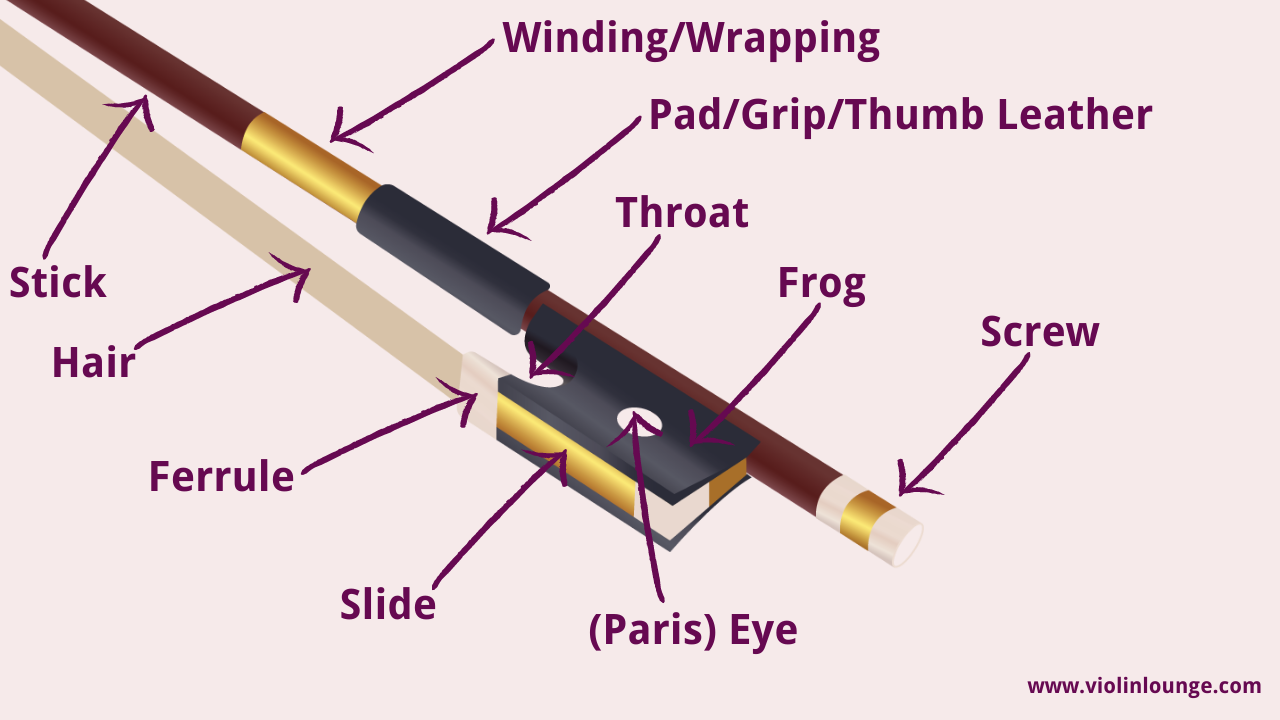
The Violin Bow Tip
 The material used for the tip of the bow is a complicated topic. The tip-plate is very important because it protects the wood of the tip from damage, so the material used must be strong. Historically, bowmakers used ivory. However, in 2016 the United States enacted a near-total ban on commercial trade of African elephant ivory. Other countries have similar laws. Bow tips fall under the very few exceptions, but only if the ivory was removed from the wild prior to 1976. Even so, traveling with such a bow requires a Musical Instrument Certificate from the U.S. Fish and Wildlife Service, which must be paid for and is only valid for three years. Many musicians choose to avoid the hassle altogether and travel with different bows. Since new bows can no longer be made with ivory, bowmakers have turned to other materials. Mammoth ivory is a popular choice. (Note that it is illegal to use materials from an endangered species, but not illegal if the species is already extinct.) Other options include bone, faux ivory (a polymer), silver, or ebony. Some student bows may simply use plastic.
The material used for the tip of the bow is a complicated topic. The tip-plate is very important because it protects the wood of the tip from damage, so the material used must be strong. Historically, bowmakers used ivory. However, in 2016 the United States enacted a near-total ban on commercial trade of African elephant ivory. Other countries have similar laws. Bow tips fall under the very few exceptions, but only if the ivory was removed from the wild prior to 1976. Even so, traveling with such a bow requires a Musical Instrument Certificate from the U.S. Fish and Wildlife Service, which must be paid for and is only valid for three years. Many musicians choose to avoid the hassle altogether and travel with different bows. Since new bows can no longer be made with ivory, bowmakers have turned to other materials. Mammoth ivory is a popular choice. (Note that it is illegal to use materials from an endangered species, but not illegal if the species is already extinct.) Other options include bone, faux ivory (a polymer), silver, or ebony. Some student bows may simply use plastic.
Hi! I'm Zlata
Let me help you find a great bow for your violin, so you can improve your bowing technique and sound quality:

Hi! I'm Zlata
Classical violinist helping you overcome technical struggles and play with feeling by improving your bow technique.
In Summary
One more word on distinguishing between bows: these days it is super easy to go online and find all sorts of cheap bows blatantly advertised as “professional quality”. Sadly, the majority of such bows are not even suitable for beginners! When selecting a bow it is SO important to go directly to a real luthier or respected instrument website that will help you find legitimate products in your price range. Your bow is your sound, so make sure you find what you are really looking for.
What type of violin bow do you have? Share it with us in the comments!

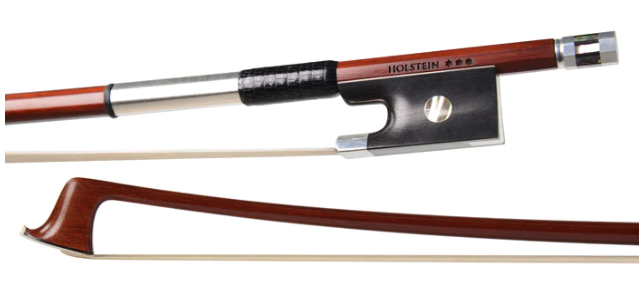
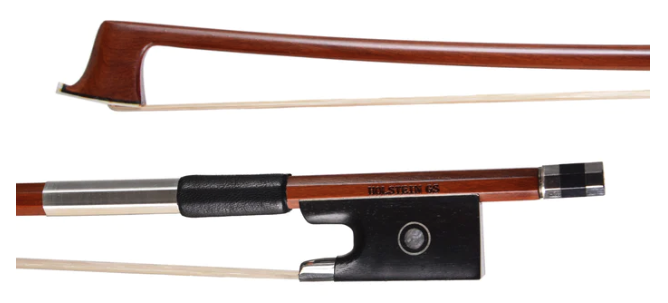
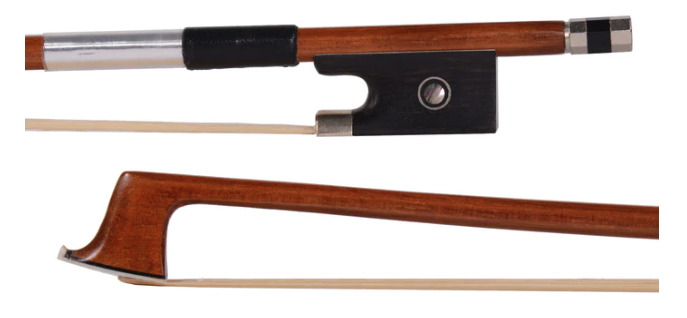
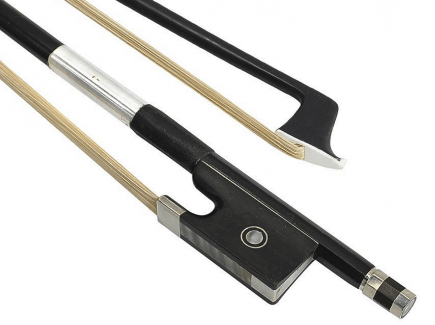
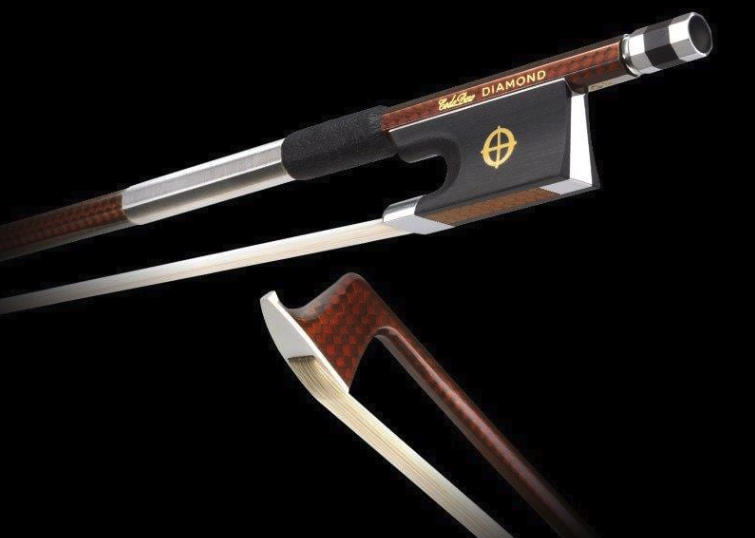
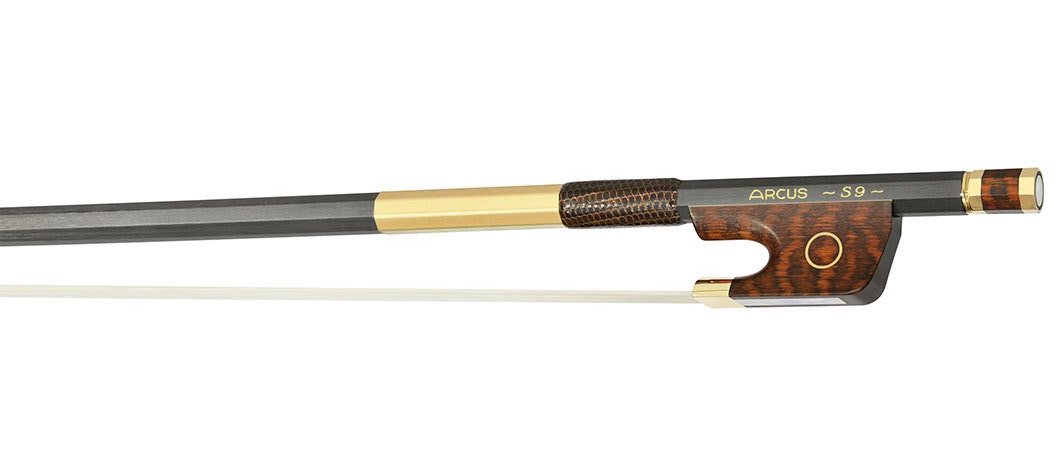
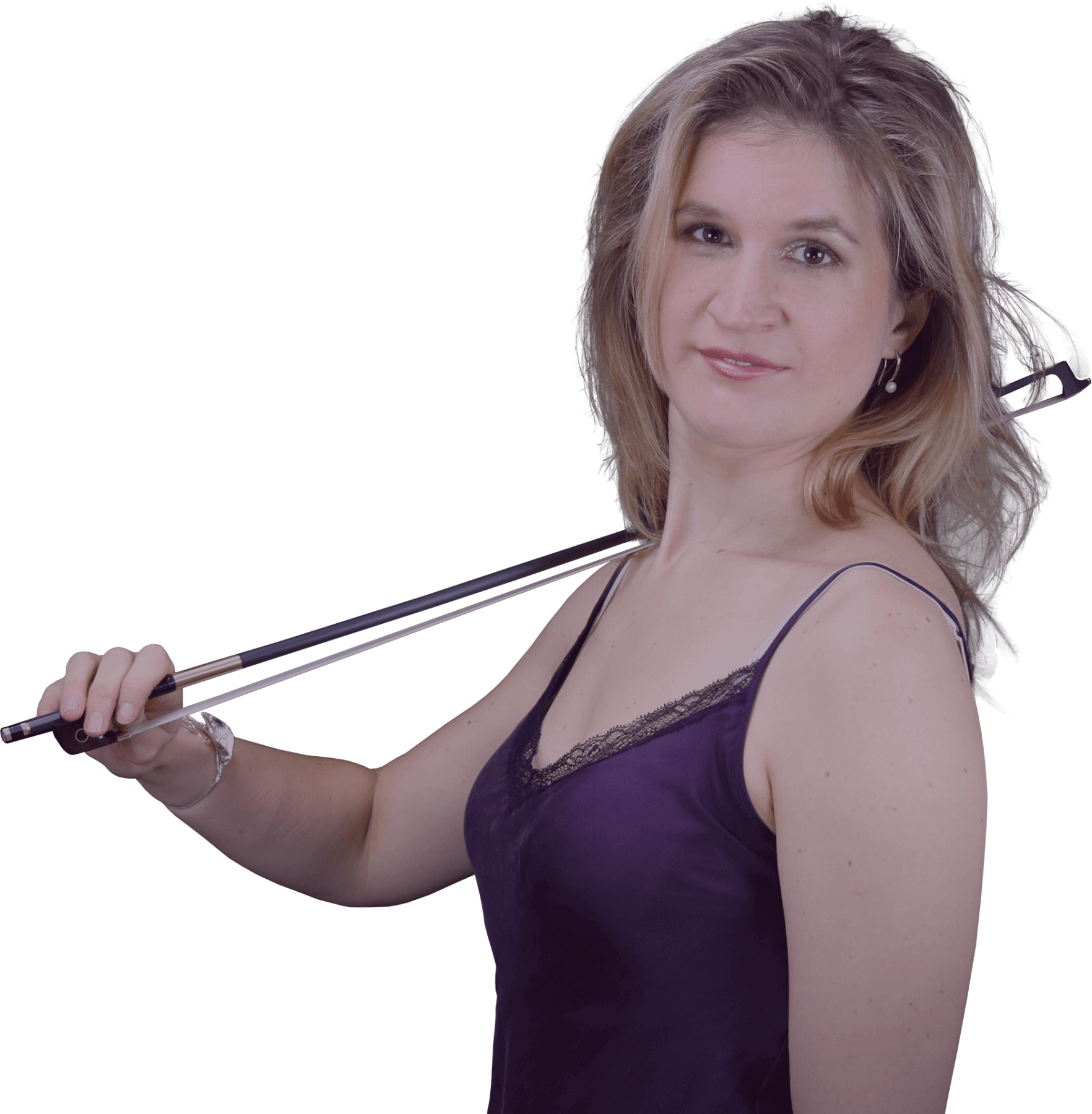
0 Comments